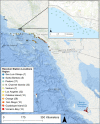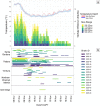Quantifying thermal cues that initiate mass emigrations in juvenile white sharks
- PMID: 36400943
- PMCID: PMC9674695
- DOI: 10.1038/s41598-022-24377-1
Quantifying thermal cues that initiate mass emigrations in juvenile white sharks
Abstract
While the function of migration varies among species, environmental temperature is known to be one of the most important abiotic variables that drive animal migration; however, quantifying the thresholds and timing of the cues that influence a mass emigration is difficult, often due to lack of monitoring resolution, particularly for large, highly mobile species. We used acoustic telemetry tracking and high-resolution water temperature data over a relatively large spatial scale (5.5 km2) to identify and quantify a thermal threshold for mass emigration of juvenile white sharks. Sixteen tagged sharks were observed to initiate a search for warmer water within 10-12 hours of an upwelling event where water temperatures dropped below 14 °C. Eleven sharks traveled ~ 35 km away where they experienced similar cold temperatures before returning to the aggregation site within 24 hours. Five days following the upwelling event, most sharks emigrated from the site for the season. Quantifying movement patterns across different spatial and temporal scales is necessary to understand cues and thresholds influencing animal migration, which may be greatly affected by climate anomalies and climate change, resulting in potential impacts on the dynamics of local prey species, management, and conservation policy and practice.
© 2022. The Author(s).
Conflict of interest statement
The authors declare no competing interests.
Figures







References
-
- Newton I. Migration within the annual cycle: Species, sex and age differences. J. Ornithol. 2011;152:169–185. doi: 10.1007/S10336-011-0689-Y/TABLES/1. - DOI
-
- Dodson S, Abrahms B, Bograd SJ, Fiechter J, Hazen EL. Disentangling the biotic and abiotic drivers of emergent migratory behavior using individual-based models. Ecol. Model. 2020;432:109225. doi: 10.1016/J.ECOLMODEL.2020.109225. - DOI
-
- Lehikoinen A, Santaharju J, Pape A, Lehikoinen MA, Santaharju J, Møller AP. Sex-specific timing of autumn migration in birds: the role of sexual size dimorphism, migration distance and differences in breeding investment. Ornis Fennica. 2017;94:53–65.
-
- Stewart, B. S. Ontogeny of differential migration and sexual segregation in northern elephant seals. J. Mammol.78(4), 1101–1116 (1997).
Publication types
MeSH terms
Substances
LinkOut - more resources
Full Text Sources

